Effective Leadership: The Qualities You Need To Become a Better Leader
The first part of this blog series investigates how drastic changes in the way we work have fundamentally transformed what it means to be a good leader and manager of teams.
In this piece, you’ll unpack some of the lessons this holds for leaders, and aspiring leaders, and explore practical steps for excelling in the future workplace by focusing on developing key leadership traits.
How to be a good leader
Both the leadership landscape and the expectations we have of leaders have changed. The inescapable conclusion is that leaders themselves must change too. This brings the growing importance of leadership development into the spotlight.
Unfortunately, leadership development is an area in which most organizations and individuals have historically fallen short. According to GetSmarter’s research, a majority of professionals currently feel that they don’t spend nearly enough time developing their leadership competencies.
Barely a quarter of our respondents possess a formal leadership development plan, and this figure drops to just 24% for individual contributors and 21% in the case of their leads.
This, in turn, has a detrimental impact on an organization’s long-term resilience and stability, as inadequate leadership development ultimately equates to the lack of a coherent succession plan.
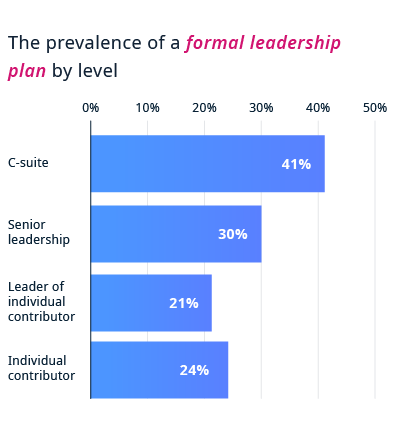
Understand that development is not equal
Leadership development is unevenly distributed across organizations. GetSmarter’s survey suggests that leaders who identify as female are much more likely as their male counterparts to state that they don’t spend enough time on their development. And almost a third of women have neither a formal leadership plan nor a career development plan in place (as opposed to only 21% of men).
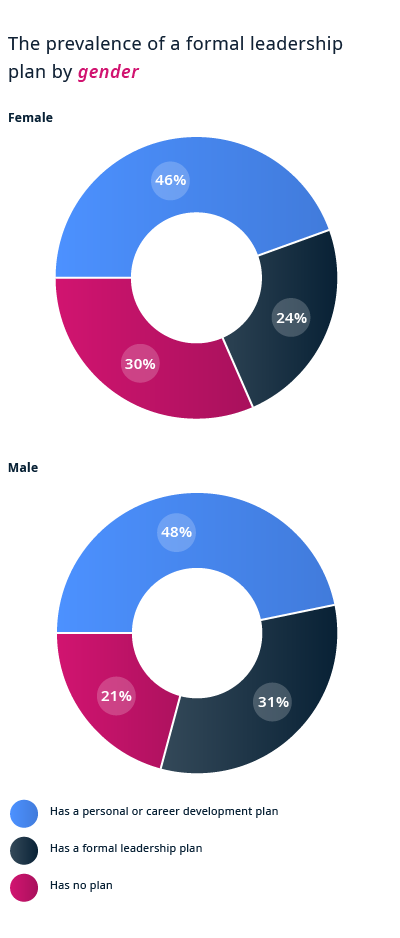
Drill down into the detail and the research reveals that female leaders of individual contributors are the group most likely to be without any sort of development plan (more than twice as likely as their male equivalents). This may be indicative of a ‘broken rung’ at the first step up to manager, where only 86 women get promoted to manager for every 100 men.1
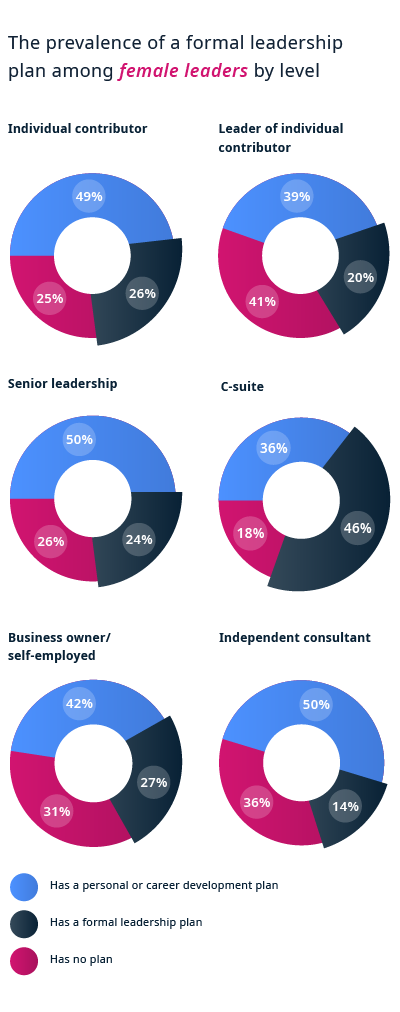
The knock-on effects of this are considerable. Fewer female managers mean fewer women are promoted at higher levels, which, in turn, deprives junior employees of critical mentorship and support (as 84% of women executives say that their mentors were key in developing their resilience).2 Furthermore, employees with women managers are more likely to say that their manager helped them with workload, burnout, emotional support, and work-life balance during times of crisis.3 And the evidence is that the more women managers an organization has in its ranks, the greater the impact those managers have on others around them.4
Learn to leverage self-acceptance, self-management, and self-development to excel as a woman in leadership.
Gender aside, the message is clear: Leadership development cannot be neglected, and all future-focused professionals need to consider creating a leadership development plan if they are to thrive. Ultimately, most organizations possess the solution to their greatest challenges within their talent pipeline. However, shortcomings in leadership development deprive them of these talents and place them at an entirely avoidable disadvantage.
Create a leadership development plan
There was a time when promising prospects entering their firm’s leadership program would effectively be set on a 20-year track to the top.5 However, the rapid rate at which companies are changing course – and employees are changing companies – has turned the once-predictable march up the corporate ladder into a snaking labyrinth of potential career paths, rife with twists and turns.
The responsibility now lies with individuals themselves to plot their own career trajectory and promote their self-development. To achieve this, an individualized leadership development plan must become a priority. While details may differ, an effective plan will incorporate these key steps:

Do a self-assessment
Compile a list of strengths and weaknesses, identifying potential pitfalls and areas for improvement. This helps frame a personal leadership style, and highlights which skills you need to fine-tune, build upon, or consider learning from scratch.

Set goals
Define a clear selection of short- and long-term goals that address both the skills you need to develop and your broader professional ambitions. Additionally, a personal mission statement can bring structure to this exercise and help you uncover your purpose.6

Add a timeline
While an entirely predictable, long-term timeline may not be realistic in today’s volatile world, a working schedule for goal achievement can help with motivation and accountability. Hooking specific actions to set dates encourages proactive steps to development. The more regular your milestones are, the more achievable they become.7

Train and upskill
Seek opportunities to learn and grow in order to bridge self-identified skills gaps, drive objectives, and stay abreast of disruption. This continuous learning should address both technical proficiencies and interpersonal or ‘soft’ skills, which have lasting relevance over the course of a career.

Be flexible
Ultimately, a plan is just that, and goals, priorities, and timelines will sometimes have to change. A network of trusted peers who offer feedback can be a powerful way to gauge progress and maintain a balanced perspective.8
Grow your traits to grow others
Increasingly, there is a realization that leaders themselves also possess the strengths to face up to their biggest challenges.
The most effective leadership style any leader can embrace is their own – executed authentically, honestly, and with a commitment to lifelong learning and growth.
GetSmarter’s research reflects this pivot: Where once the focus was on leading the organization, optimizing systems, and future-proofing against macroeconomic events, respondents today understand that principles such as self-awareness and inspiring people engagement will be the new leadership imperatives.
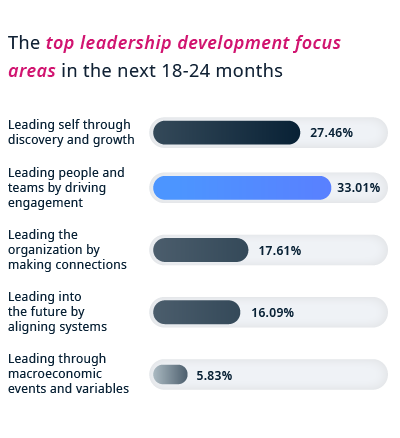
There is no magic bullet for world-class leadership, but any leader can become the best version of themselves by committing to their own development and focusing on a handful of key behaviors, as expressed by five of our survey respondents:
“Trust and be trusted.”
Engendering trust is non-negotiable for leaders today – especially since the advent of remote and hybrid working conditions. Trustworthy companies perform 2.5 times better than non-trustworthy ones,9 and high levels of trust are linked with greater customer satisfaction, enhanced employee engagement, and improved representation.10 In periods of crisis, honesty and trust can help create stability and give employees confidence that they are cared for and understood. In turn, this can inspire loyalty and provide a safe space for innovation when the corner is turned. Roughly three-quarters of professionals see senior leaders as responsible for building trust,11 making the imperative for organizations crystal clear.
Develop an adaptive approach to leadership that’s built on trust, clarity, and momentum.
In the following video, Mark McGinn, director of brand and social purpose at Edelman, and a guest lecturer on the Communicating for Influence and Impact online short course from the University of Cambridge Institute for Sustainability Leadership (CISL), explains the importance of establishing trust in a volatile world:
“Be an active listener and seek honest feedback on your leadership approach.”
If empathy is the one leadership characteristic most desired today, clear, participative, and ‘democratic’ communication is the best way leaders are able to transmit it. Studies show that simple initiatives like regularly scheduled one-on-ones and providing opportunities for anonymous feedback can help employees feel more comfortable about having honest discussions with their manager. And openness, transparency, and the ability to handle difficult conversations are all key qualities employees look for in an empathetic leader.
Gain the tools to inspire and motivate diverse teams through strategic communication.
In this video, Dr Louise Drake, course director in sustainability leadership at CISL and a guest lecturer on the Communicating for Influence and Impact online short course, discusses how leaders today must build collective enthusiasm for a shared purpose by involving a diversity of voices:
“Keep learning how to develop and empower people.”
Like leaders, the vast majority (77%) of workers want to develop themselves and upskill.13 GetSmarter’s 2020 The Future of Work Is Here report revealed that promoting a culture of learning not only helps close critical skills gaps, but can substantially enhance employee engagement and motivation levels. And employees who feel that they have opportunities for personal and professional growth are much more likely to stick around.14
Sue Dopson, a Programme Director on the Oxford Women’s Leadership Development Programme from Saïd Business School, University of Oxford, describes effective leadership using the example of a farmer, who may not take part in every single project but creates the conditions in which others can thrive:
“Be true to yourself and your vision.”
The numbers are sobering: Less than half of US employees strongly agree that they know what their organization stands for, and only 22% feel that their leaders have a clear direction for the business.15 Defining your organizational purpose and clearly articulating this vision to all employees doesn’t just inspire teams to improve, it empowers them to succeed. Phil Smith, a guest expert on the Oxford Executive Leadership Programme from Saïd Business School, University of Oxford, explains the importance of having an ambitious vision in business today:
“If you’re not developing, you can’t help others develop.”
While the majority of CEOs acknowledge that developing the next generation of leaders is one of their greatest challenges, only 28% of leaders are currently being developed in critical skills for the future.16 The best way to develop your people is to start by developing yourself. After all, no leader is expected to be the finished product – in fact, we look up to those who acknowledge that they’re always working on bettering themselves.
Develop your personal leadership identity to confidently and effectively influence and manage others.
Run through the five characteristics that make a great leader today in this shareable animated video:
Upskill to lead the way
The lesson is clear: Our view of leadership has changed, and all leaders – whether vastly experienced or new to the role – must change with it. Seeking out coaching and mentorship opportunities, online resources, and on-the-job training are all valuable ways of developing your leadership skill set for any situation. Another highly effective method is to embark upon an online executive education program. Our respondents voted this as one of the best ways to foster leadership skills and attain one’s leadership goals.
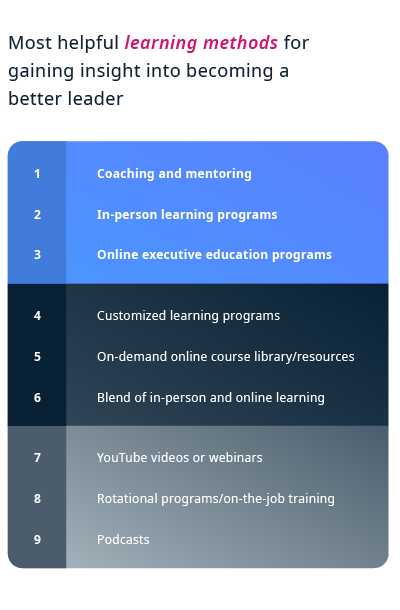
GetSmarter’s courses combine a people-mediated approach to content delivery with the high-touch support of both Success Advisers and expert tutors, giving you all the benefits of online learning with a hands-on edge. Watch this video to learn more:
Now is the time to reevaluate your leadership approach for the challenges that lie ahead. So, what kind of leader are you? Or, more importantly, what kind of leader would you like to become?
GetSmarter has a wide range of online short courses dedicated to equipping future-focused professionals with the leadership and interpersonal competencies to thrive. Start upskilling today to succeed in the workplace of tomorrow.
- 1 Krivkovich, A. et al. (Sep, 2021). ‘Women in the workplace 2021’. Retrieved from McKinsey.
- 2 (2021). ‘Advancing the Future of Women in Business’. Retrieved from KPMG Women’s Leadership Summit.
- 3 Krivkovich, A. et al. (Sep, 2021). ‘Women in the workplace 2021’. Retrieved from McKinsey.
- 4 Beales, J. (Mar, 2022). ‘How women in leadership are changing the landscape of work in 2022’. Retrieved from Lever.
- 5 Gavin, M. (Nov, 2019). ‘5 Steps to creating a successful leadership development plan’. Retrieved from the Harvard Business School Online.
- 6 (Apr, 2022). ‘How to create an action plan for leadership development’. Retrieved from indeed.
- 7 (Nd). ‘4 Best ways to create leadership development plans’. Retrieved from IMD. Accessed July 25, 2022.
- 8 Gavin, M. (Nov, 2019). ‘5 Steps to creating a successful leadership development plan’. Retrieved from the Harvard Business School Online.
- 9 (2021). ‘The future of trust: A new measure for enterprise performance’. Retrieved from Deloitte.
- 10 (Jan, 2022). ‘Reimagining the outcomes that matter’. Retrieved from PwC.
- 11 (Sep, 2021). ‘The complexity of trust: PwC’s Trust in US Business survey’. Retrieved from PwC.
- 12 (Feb, 2022). ‘How empathetic leadership can fix the Great Resignation’. Retrieved from EY.
- 13 (2021). ‘Hopes and fears 2021’. Retrieved from PwC.
- 14 Fenton, M. et al. (Jan, 2022). ‘When the grass is truly greener: How companies are retaining frontline talent’. Retrieved from McKinsey.
- 15 Ratanjee, V. (Oct, 2021). ‘Leaders: Bring your strategy back into focus’. Retrieved from Gallup.
- 16 Neal, S. et al. (2021). ‘Global Leadership Forecast 2021’. Retrieved from DDI.